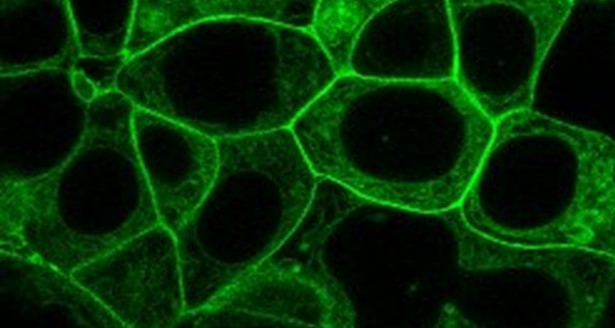
Two recent papers by Northwestern Proteomics researchers demonstrate the critical importance of proteoform analysis (the study of all of the different forms of proteins in the human body) in developing and refining treatments for cancer and other diseases.
“Proteoforms matter,” says Michael Caldwell, PhD, scientific officer of Northwestern Proteomics. “Measuring proteoforms is really hard, so most people don’t do it, but we as a lab have spent many years investing in developing the technology and techniques that let us apply this approach to new research projects.”
Slowing cancer growth
Lauren Adams, PhD, a recent Northwestern graduate and a Northwestern Proteomics researcher, led a study that cataloged proteoforms of KRAS, a protein that is frequently mutated in colorectal and lung cancers, in tumors and lab-grown cancer cells. KRAS has two isoforms, or forms of the protein with different amino acid sequences, KRAS4A and KRAS4B. Using top-down mass spectrometry, Adams found that KRAS4B was more abundant than KRAS4A, and that mutant KRAS proteoforms were more abundant than originally thought, she says. Both of these findings can help scientists better understand how the different forms of KRAS and their amounts impact their role in cancer.
“The third finding, which was the most exciting, is we actually found this whole novel class of proteoforms for KRAS,” Adams says. “You don’t expect to see that in a field that’s so well studied, yet with top-down I was actually able to discover something novel about it. That was pretty cool.”
These novel proteoforms were missing a key amino acid that drives cancer cell growth, Adams says. Adams said this discovery could inspire therapeutics designed to slow cancer cell growth by converting other proliferative KRAS proteoforms into this newly discovered form.
A new target for drug development
Ashley Ives, a PhD candidate researching with Northwestern Proteomics, also used proteoform techniques in a recent study. She researched G protein-coupled receptors (or GPCRs), a general class of signaling protein that communicates signals across the cell membrane. Since GPCRs are large and insoluble in water, which makes them hard to analyze in the lab, she used a ‘middle-down’ approach to study them. To do this, she chemically cuts off the tails (the domain that sits on the inside of the cell) of the proteins and studied the tails separately. These GPCR tails are phosphorylated and help with communicating signals throughout the cell based on external stimuli. She then studied the pattern of modified amino acids, or phosphorylation barcode, along the GPCRs tails. Like reading braille, other proteins ‘feel’ the barcode to pass on signals.
By studying the entire tail and its forms, Ives could see the barcode, which includes ten or more phosphorylation sites, in its entirety and determine which sites phosphorylate separately or together. Eventually, this research could inform new therapies that target GPCR proteins more specifically.
“From what I’ve seen, a lot of drugs that target GPCRs act as a rudimentary on or off switch. Either the drug blocks the GPCR completely and shuts it off or the opposite; it activates it,” Ives says.
With this proteoform knowledge, says Ives, scientists may be able to develop more refined treatments that only limit or increase particular signals, rather than turn them all the way on or off. They may also target specific cell partners for signaling. Since GPCRs are found in all parts of the body, these treatments could help with a wide variety of issues, from cancer to neurological diseases.
While proteoform analysis and the top- and middle-down approaches are not used by many labs, Northwestern Proteomics uses them effectively to study entire forms of proteins and discover new and better drug targets for commonly researched proteins.
by Grace Finnell-Gudwien
Image caption: Confocal microscope image of HEK293T stable cell line expressing mGluR2 with an N-terminal GFP tag and TEV protease site between residues A830 and P831. Image was taken post FACS-sorting in which the middle tercile of cells were selected based on GFP intensity. (Source: Ashley Ives)

